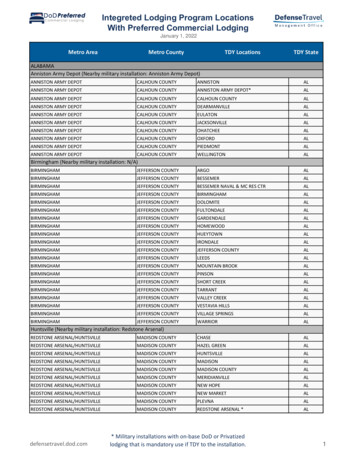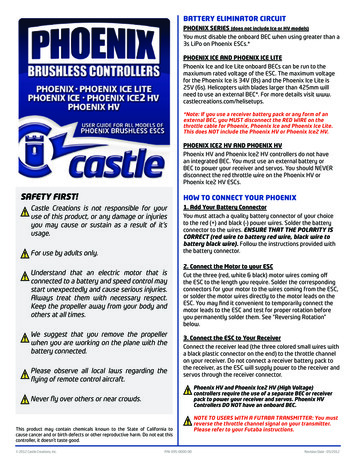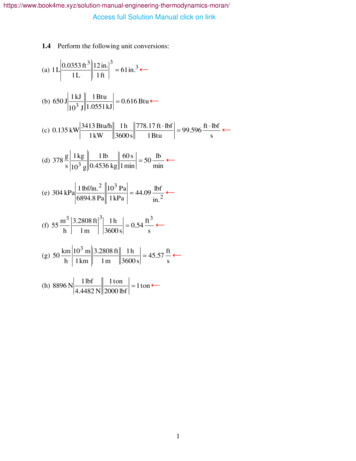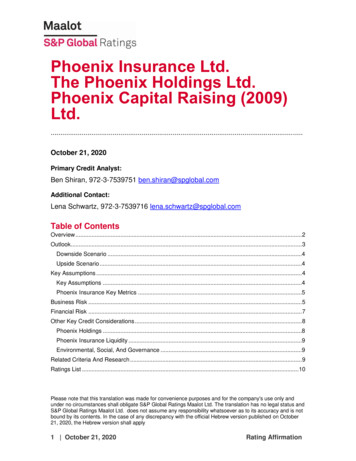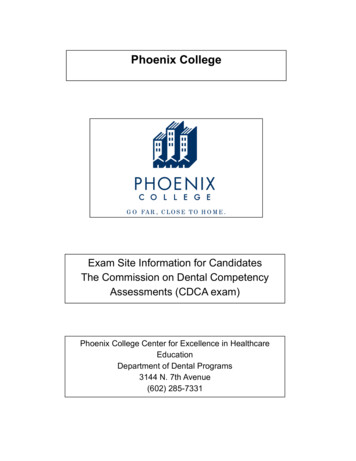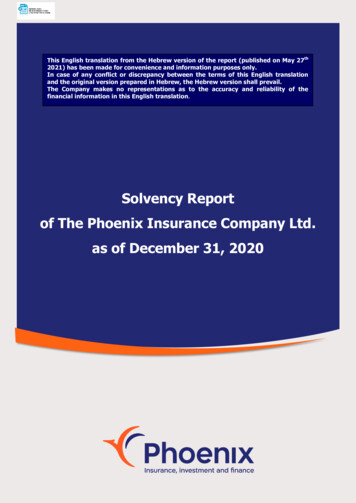
Transcription
This English translation from the Hebrew version of the report (published on May 27th2021) has been made for convenience and information purposes only.In case of any conflict or discrepancy between the terms of this English translationand the original version prepared in Hebrew, the Hebrew version shall prevail.The Company makes no representations as to the accuracy and reliability of thefinancial information in this English translation.Solvency Reportof The Phoenix Insurance Company Ltd.as of December 31, 202034 / 1
Table of ContentsPageSpecial Auditor’s Report . 3Overview and Disclosure Requirements . 5Definitions. 7Calculation Methodology . 9Section 1 - Solvency Ratio and MinimumCapital Requirement . 14Section 2 - Economic Balance Sheet . 16Section 2.A - Information about Economic Balance Sheet . 18Section 2.B - Composition of liabilities in respect toInsurance contracts and investment contracts . 24Section 3 - Own Funds in respect of SCR . 25Section 4 - Solvency Capital Requirement (SCR) . 27Section 5 - Minimum Capital Requirement (MCR) . 29Section 6 - Effect of Transitional Measures . 30Section 7 - Analysis of Sensitivity to Changes in Interest Rates . 31Section 8 - Dividend Distribution Restrictions . 32Dummy Text2
Economic Solvency Ratio Report as of December 31, 2020Kost Forer Gabbay & KasiererTel. 972-3-6232525Menachem Begin Road 144A,Tel Aviv 6492102Fax 972-3-5622555ey.comTo:The Board of Directors ofThe Phoenix Insurance Company Ltd.Re: Examination of the Application of Certain Instructions of the Commissioner of theCapital Market, Insurance and Savings regarding the Solvency II-Based EconomicSolvency Requirement of The Phoenix Insurance Company Ltd. (hereinafter - the“Company”) as of December 31, 2020We examined the capital required to maintain the solvency capital requirement (hereinafter “SCR”) and the economic capital of The Phoenix Insurance Company Ltd. of December 31 2020(hereinafter – the “Information”), included in the Company’s Solvency Report attached hereby andcarries our office’s seal for identification purposes (hereinafter - the “Report”).The Board of Directors and management bear the responsibility for the preparation and presentationof the Information drawn up in accordance with the directives of the Commissioner of the CapitalMarket, Insurance and Savings (hereinafter - the “Commissioner”) regarding Solvency II-basedEconomic Solvency Requirement of an insurance company as included the Commissioner’s circularNo. 2020-1-15 of October 14 2020, and in accordance with the Commissioner’s directivesregarding principles for calculation of deduction during the transitional period in a Solvency IIbased Economic Solvency Regime of October 15 2020 (hereinafter - the “Directives”).The calculations, forecasts and assumptions on which the preparation of the Information wasbased fall under the responsibility of the Board of Directors and management.We conducted our examination in accordance with International Standard on AssuranceEngagements No. 3400 - The Examination of Prospective Financial Information, and in accordancewith the Commissioner’s Directives, as included in Appendix B of the Insurance Circular 2017-120 of December 3 2017, which provides guidance as to audit of Economic Solvency Ratio Report.We did not examine the appropriateness of the deduction during amount the transitional period as ofDecember 31 2020 as presented in Section 2 to the Report, except for examination that thededuction amount does not exceed the expected discounted amount of the risk margin and thecapital required for solvency in respect of life and health insurance risks arising from existingbusinesses during the transitional period in accordance with the pattern of future development of therequired capital, which affects both the calculation of the expected capital release and the release ofthe expected risk margin as described in the provisions on calculation of risk margin.The Phoenix Insurance Company Ltd.Dummy Text3
Economic Solvency Ratio Report as of December 31, 2020Except for what is stated above in connection with the appropriateness of the deduction during thetransitional period, based on the examination of the evidence supporting the calculations, theforecasts and the assumptions, as referred to below, which were used by the Company’s Board ofDirectors and management in the preparation of the information nothing came to our attentionwhich caused us to believe that the forecasts and assumptions, as a whole, do not constitute areasonable basis for the information in accordance with the Directives. Furthermore, in our opinion,the information, including the method employed to determine the assumptions and forecasts, wasprepared and presented in all material respects in accordance with the Directives.It should be emphasized that the projections and assumptions are based mainly on past experience,as arising from actuarial studies conducted from time to time. In view of the reforms in the capitalmarket, insurance and savings, and the changes in the economic environment, past data do notnecessarily reflect future results. The information is sometimes based on assumptions regardingfuture events, steps taken by management, and the pattern of the future development of the riskmargin, that will not necessarily materialize or will materialize in a manner different than theassumptions used in the information. Furthermore, actual results may materially vary from theinformation, since the combined scenarios of events may materialize in a manner that is materiallydifferent than the assumptions made in the information.We draw attention to what is stated in Section e - d comments and clarifications regarding thesolvency ratio, the uncertainty derived from regulatory changes and exposure to contingentliabilities, the effect of which on the solvency ratio cannot be estimated.Respectfully,Tel Aviv,May 26, 2021The Phoenix Insurance Company Ltd.Kost Forer Gabbay & KasiererCertified Public Accountants4
Economic Solvency Ratio Report as of December 31, 2020A. Overview and Disclosure RequirementsSolvency II-based Economic Solvency RegimeThe information provided below was calculated in accordance with the provisions of Circular 2020-1-15 of theCommissioner of the Capital Market, Insurance and Savings (hereinafter - the “Commissioner”) - “Amendment tothe Consolidated Circular concerning Implementation of a Solvency II-Based Economic Solvency Regime forInsurance Companies” (hereinafter - the “Economic Solvency Regime Directives”), was prepared and presentedin accordance with Chapter 1, Part 4 Section 5 of the Consolidated Circular as recently revised in Circular 2020-1-17(hereinafter - the “Disclosure Provisions”).The Economic Solvency Regime provisions set a standard model for calculating eligible capital and the regulatorysolvency capital requirement, with the aim of bringing insurance companies to hold buffers to absorb losses arisingfrom the materialization of unexpected risks to which they are exposed. The solvency ratio is the ratio betweenan insurance company’s eligible capital to its regulatory solvency capital requirement.The eligible capital is composed of Tier 1 Capital and Tier 2 Capital. Tier 1 Capital includes own funds calculatedthrough assessing the value of an insurance company’s assets and liabilities in accordance with the circular’sprovisions, and Additional Tier 1 Capital. Additional Tier 1 Capital and Tier 2 Capital include equity instruments withloss absorption mechanisms, including Subordinated Tier 2 Capital, Hybrid Tier 2 Capital and Tier 3 Capital, whichwere issued prior to the circular’s effective date. The circular places restrictions on the composition of capital forSCR and MCR purposes (see below), such that the rate of components included in Tier 2 Capital shall not exceed40% of the SCR without taking into account the transitional provisions and the equity scenario adjustment, and shallnot exceed 50% of the SCR under the transitional provisions and taking into account the equity scenarioadjustment.The eligible capital is compared to the required capital and there are two levels of capital requirements: The capital required to maintain an insurance company’s solvency (Solvency Capital Requirement, hereinafter “SCR”). The SCR is risk-sensitive, and is based on forward-looking calculation of the impact of thematerialization of different scenarios, while taking into account the correlation of the different risk factors,based on the guidance in the Economic Solvency Regime Directives. Minimum capital requirement (hereinafter “MCR” or “Capital Threshold”). In accordance with the EconomicSolvency Regime Directives, the Capital Threshold shall be equal to the amount derived from insurance reservesand premiums (as defined in the Solvency Circular), with a floor of 25% and a cap of 45% of the SCR.The eligible capital and the required capital are calculated using data and models which are based, among otherthings, on forecasts and assumptions that rely mainly on past experience. These calculations are highly complex.The Economic Solvency Regime Directives include, among other things, transitional provisions and adjustment forequity scenario, as follows:A.Selecting one of the following alternatives:1. Gradual transition to the required capital until 2024 (hereinafter - the “Transitional Period”), such that therequired capital shall increase gradually by 5% per year, starting with 60% of the SCR up to the full SCRamount.The Phoenix Insurance Company Ltd.5
Economic Solvency Ratio Report as of December 31, 20202. Increasing the eligible capital by deducting from the insurance reserves an amount that will be calculated inaccordance with Section c below. The deduction amount will decrease gradually until 2032 (hereinafter: the“Deduction During the Transitional Period” or "Transitional Measures on Technical Provisions – TMTP").The Company opted for the second alternative - of using the Deduction During the Transitional Period.B.In addition to Section A above, the Economic Solvency Regime includes a reduced capital requirement, thatwill increase gradually until 2023, in respect of certain investment types.Forward-looking informationThe data included in this Economic Solvency Ratio Report, including the eligibleand the required capital for solvency purposes are based, among other things, onforecasts, assessments, and estimates of future events, the materialization ofwhich is uncertain and is not under the Company’s control, and which should beconsidered as “forward-looking information” as the term is defined in Section 32Ato the Securities Law, 1968. Actual results may differ from the results reflected inthis Economic Solvency Ratio Report, if such forecasts, assessments and estimates,either in whole or in part, fail to materialize or materialize in a manner differentthan anticipated, including, among other things, with respect to actuarialassumptions (including mortality rates, morbidity rates, recovery rates, lapses,expenses, take up of pension benefits, rate of release of the risk margin andunderwriting earnings rate), assumptions regarding future management actions,risk-free interest rates, capital market returns, future revenue, and damage incatastrophe scenarios.The Phoenix Insurance Company Ltd.6
Economic Solvency Ratio Report as of December 31, 2020B. DefinitionsCompany-The Phoenix Insurance Company Ltd.-The provisions of Circular 2020-1-15 of the Commissioner of the Capital Market,The Economic SolvencyRegime DirectivesInsurance and Savings (hereinafter - the “Commissioner”) - “Amendment to theConsolidated Circular concerning Implementation of a Solvency II-Based EconomicSolvency Regime for Insurance Companies” (hereinafter - the “Solvency Circular”),including its explanations.Best estimate-Expected future cash flow from insurance contracts and investment contractsthroughout their term, without conservatism margins and discounted by an adjustedrisk-free interest.SLT health insurance-Health insurance that is conducted similarly to life insurance.NSLT health insurance-Health insurance that is deemed to be written on a similar technical basis as propertyand casualty insurance (i.e. short term business)Basic solvency capitalrequirement (BSCR)-The capital required from an insurance company to maintain its solvency, calculated inaccordance with the Economic Solvency Regime Directives, without taking intoaccount the capital required due to operational risk, adjustment to loss absorption dueto deferred tax and required capital due to management companies.Solvency capitalrequirement (SCR)-Total capital required from an insurance company to maintain its solvency, calculatedin accordance with the Economic Solvency Regime Directives.Recognized Own funds-Total Tier 1 Capital and Tier 2 Capital of an insurance company, after deductions andamortization in accordance with the provisions of Part B of the Appendix to theSolvency Circular.Basic Tier 1 capital-Excess of assets over liabilities in the economic balance sheet, net of unrecognizedassets and dividend declared subsequent to balance sheet date and until the report’sinitial publication date.Additional Tier 1 capital-Perpetual capital note, non-cumulative preferred shares, Restricted Tier 1 capitalinstrument, Additional Tier 1 Capital instrument -valued in accordance with theprovisions of Part A of the Appendix to the Solvency Circular.Tier 2 capital-Tier 2 Capital instruments, Subordinated Tier 2 Capital, Additional Tier 1 Capitalinstrument that was not included in Tier 1 and Hybrid Tier 3 Capital - valued inaccordance with the provisions of Part A of the Appendix to the Solvency Circular.The Commissioner-Commissioner of the Capital Market, Insurance and Savings Authority.-Effect of the partial correlation between different risks in the model on their amounts;Effect of diversificationof risk componentsthe greater the diversification between operating segments in the portfolio and theThe Phoenix Insurance Company Ltd.7
Economic Solvency Ratio Report as of December 31, 2020diversification between risks, the greater is the effect of the correlation, whichreduces the overall risk.Solvency ratio-The ratio between the eligible equity of an insurance company and the solvencycapital requirement.Equity scenarioadjustment-A reduced capital requirement for certain types of investments that will graduallyincrease until 2023, when the capital requirement in respect of these investments willreach its maximum rate.Economic balance sheet-The Company’s balance sheet with the value of assets and liabilities adjusted inaccordance with the provisions of Part A of the Solvency Circular.Risk margin (RM)-An amount that reflects the total cost of capital that is expected to be required fromanother insurance company or reinsurer in order to assume the Company’s insuranceliabilities.Deduction During theTransitional Period/-The amount deducted from insurance reserves during the Transitional Period, asTransitional Measuresdescribed in Section 2a(2) above, and in accordance with the Economic Solvencyon Technical Provisions/Regime Directives.TMTPMinimum capitalrequirement-The minimum capital required from an insurance company, calculated in accordancewith Chapter C of the Solvency Circular.EPIFP-Expected Profit in Future Premiums; the future profit from liabilities in respect ofexisting life and health insurance contracts arises from future premiums.Transitional Period-Under the transitional provisions for the implementation of an Economic SolvencyRegime - a period running until December 31 2032.UFR-Ultimate Forward Rate - the latest forward interest rate derived from the expectedlong-term real interest rate and the long-term inflation expectations to which theadjusted interest-rate curve converges, in accordance with the Economic SolvencyRegime Directives.Acomponent reflecting the margin implicit in a representative debt assets portfolio ofVolatility Adjustment(VA)-Audited-insurance companies and added to the adjusted interest-rate curve in accordance withEconomic Solvency Regime Directives.The term refers to an audit held in accordance International Standard on AssuranceEngagement (ISAE) 3400 – “The Examination of Prospective Financial Information.”Supervision of Financial Services Regulations (Provident Funds) (Investment RulesInvestment RulesRegulations-Applicable to Institutional Entities), 2012.The Phoenix Insurance Company Ltd.8
Economic Solvency Ratio Report as of December 31, 2020C. Calculation MethodologyThe Economic Solvency Ratio Report as of December 31 2020 and December 31 2019 was calculated and preparedin accordance with the Economic Solvency Regime Directives.Economic balance sheetThe economic balance sheet is calculated in accordance with the detailed rules and directives published by theCommissioner, which are based on the European Solvency II rules, with adjustments to reflect the characteristicsof the economic environment and products in Israel. The purpose of the rules is to reflect the economic value ofthe balance sheet items in accordance with the Commissioner’s approach. In accordance with the Directives, theinsurance liabilities are calculated based on the best estimate of all expected future cash flows from existingbusinesses, without conservatism margins and plus a risk margin, which represents the addition to the insuranceliabilities that is expected to be required from another insurance company to assume the insurance company'sinsurance liabilities. In accordance with the Directives, the risk margin is calculated using the cost of capitalmethod, at a rate of 6% per year of the expected required capital in respect of insurance risks over the life of theexisting businesses as described below. The economic balance sheet is prepared based on the Company’sstandalone financial statements plus investees, whose main occupation is holding rights in real estate. Theeconomic balance sheet does not include the economic value of the provident funds and pension funds activitiesheld by the insurance company and assumes zero value of intangible assets and deferred acquisition costs.Increasing economic capital according to the transitional provisionsAs aforesaid, the Company opted for the TMTP alternative provided by the transitional provisions, whereby theeconomic capital may be increased by gradually deducting from the insurance reserves until 2032. With regard tothe Deduction During the Transitional Period, a letter was addressed to insurance companies managers titled“Principles for calculating Deduction During the Transitional Period in the Solvency II-based Economic SolvencyRegime” (hereinafter - the “Letter of Principles”). Pursuant to the Letter of Principles, the Deduction During theTransitional Period shall be calculated by dividing insurance policies issued through December 31 2016 intohomogeneous risk groups.The aforesaid deduction shall be calculated as the difference between insurancereserves (retention) as per the economic balance sheet including the risk margin attributed thereto (withoutadjusting the fair value of designated bonds) and the insurance reserves (retention) as per the FinancialStatements. This difference shall be deducted on a linear basis until December 31 2032.The Company should ensure that the deduction balance at each reporting date (hereinafter - the “Deduction ValueDuring the Transitional Period”) shall be proportionate to the expected increase in the solvency ratio calculatedexcluding the Transitional Measures.The Deduction During the Transitional Period shall be recalculated in subsequent periods in the following instances:(a)Every two years, after obtaining the Commissioner’s approval.(b)If a material change occurred in the risk profile or the business structure of the insurance company;(c)At the request of the Commissioner, if he/she believed that circumstances have changed since approval wasgiven.The Phoenix Insurance Company Ltd.9
Economic Solvency Ratio Report as of December 31, 2020In March 2020, the Commissioner published an amendment to the provisions of the Consolidated Circular regardingthe Liability Adequacy Testing (hereinafter - the “LAT Circular”). The amendment included changes in the wayinsurance liabilities are calculated as part of the Liability Adequacy Test (LAT), and determined that these changeswould apply from the financial statements as of March 31 2020 as a change in accounting policies by way ofretrospective application. In accordance with the Commissioner’s Directives, the said amendment is not reflected inthe calculation of the Deduction During the Transitional Period as of December 31 2019 and is not reflected in theBalance sheet according to accounting standards shown in section 2 below.In March 2021, the Commissioner published a clarification in connection with this issue, stipulating that thecalculation of the LAT Circular’s effect on the Deduction During the Transitional Period as of December 31 2020shall be carried out retrospectively, as follows:The Deduction During the Transitional Period will be calculated as of December 31 2019 using the same method asthe one used to calculate the Solvency Report for that date; the accounting-based insurance liabilities include theeffect of the LAT Circular, and the economic-based insurance liabilities (best estimate plus risk margin) and addedfair value of the designated bonds include the effect derived therefrom. The Deduction During the TransitionalPeriod as of December 31 2020 shall be based on the Deduction During the Transitional Period that was calculatedretrospectively and will be deducted as described above. For further details as to the effect of this change, seeSection 1a below.Solvency capital requirement (SCR)The calculation of the solvency capital requirement is based on an assessment of the economic capital’s exposureto the following risk components set in the Economic Solvency Regime: life insurance risks, health insurance risks,property and casualty insurance risks, market risks and counter-party default risks. These risk components includesub-risk components with respect to specific risks to which the insurance company is exposed. The exposureassessment of the economic equity to each sub-risk component is carried out based on a defined scenario set outin the guidance. The determination of the solvency capital requirement is based on the sum of the capitalrequirements in respect of the risk components and the sub-risk components, as stated above, net of the effect ofthe diversification between the risks in the Company in accordance with the correlations assigned to them underthe Directives, and net of an adjustment for loss-absorption due to deferred tax, as set out below. Furthermore,the calculation of the solvency capital requirement includes components of capital required in respect of operationalrisk and in respect of management companies.The capital requirement in respect of each of the risks is calculated in accordance with the Company’s exposure tothat risk, taking into account the parameters set in the Directives. In accordance with the Directives, the amount ofthe required capital represents the scope of capital that will allow the insurance company to absorb unexpectedlosses in the forthcoming year and meet its obligations to policyholders and beneficiaries on time, with a 99.5%certainty level.The Phoenix Insurance Company Ltd.10
Economic Solvency Ratio Report as of December 31, 2020Loss absorption adjustment due to deferred tax assetIn accordance with the Economic Solvency Regime Directives, an insurance company may recognize a lossabsorption adjustment with respect to deferred tax assets up to the amount of the balance of the deferred taxreserve included in the economic balance sheet plus a tax asset against future profits up to 5% of the basicsolvency capital requirement (BSCR), provided that the following conditions are met: The insurance company is able to demonstrate to the Commissioner that it is probable that it will have futuretaxable income against which the tax assets may be utilized. The future profits shall arise only from property and casualty insurance or from NSLT health insurance (shortterm health insurance) only.The Phoenix Insurance Company Ltd.11
Economic Solvency Ratio Report as of December 31, 2020D. Comments and clarifications1. GeneralThe economic solvency ratio report includes, among other things, forecasts based on assumptions andparameters based on past experience, as they arise from actuarial studies conducted from time to time, andon Company’s assessments regarding the future, to the extent that it has relevant and concrete informationwhich can be relied upon. The information and studies are similar to those used as the basis for theCompany’s annual 2020 report. Any information or studies obtained or completed after the Company’s 2020annual report publication date were not taken into account.It should be emphasized that in view of the reforms in the capital, insurance and savings market and thechanges in the economic environment, past data are not necessarily indicative of future results, and theCompany is unable to reliably assess the effect of the reform and the changes. The calculation is sometimesbased on assumptions regarding future events and steps taken by management, that will not necessarilymaterialize or will materialize in a manner different than the assumptions used in the calculation. Furthermore,actual results may materially vary from the calculation, since the combined scenarios of events may materializein a manner that is materially different than the assumptions made in the calculation.The model, in its present form, is highly sensitive to changes in market variable and other variables; therefore,the status of capital reflected therefrom may be very volatile.2. Future effects of legislation and regulatory measures known as of the report’spublication date and exposure to contingent liabilitiesa)The field of insurance has been subject to frequent changes in relevant legislation and regulatorydirectives. For further details, see Sections 2.1.2 and 2.3.1 in Part B and Section 4.1 in Part D of theDescription of the Corporation Business chapter in the 2020 Periodic Report.Legislation and regulatory measures impact the Company’s profits and cash flows and consequentlyalso its economic solvency ratio.The calculation of the solvency ratio does not reflect all potential effects of the aforesaid legislationand regulatory measures and of other developments that are not yet reflected in practice in the data;this is since to date the Company is unable to assess their entire effect on its business results andsolvency ratio.b)In accordance with the Economic Solvency Regime Directives, the value of contingent liabilities in theeconomic balance sheet is determined based on their value in the accounting balance sheet inaccordance with the provisions of IAS 37; this measurement does not reflect their economic value. Itis not possible to assess the effect of the uncertainty arising from the exposure to contingent liabilities,including such exposure's effect on the Company’s future profits and economic solvency ratio. Forfurther information regarding the exposure to contingent liabilities, please see Note 39 to the financialstatements as at December 31 2020. For an update as to developments in this exposure afterreporting date, see Note 7 to the financial statements as of March 31 2021.The Phoenix Insurance Company Ltd.12
Economic Solvency Ratio Report as of December 31, 2020c)On May 13 2021, the Commissioner published a revised version of the Q&A file regarding theapplication and disclosure of Economic Solvency Regime of insurance companies (hereinafter - the“Q&A File”). The Q&A File provides a clarification as to the contract boundary in savings policieswithout a guaranteed conversion factor which were marketed after 2013. The clarification stipulatesthat the contract’s boundary is the date on which the guaranteed conversion factor is secured;furthermore, it was noted that for the calculation as of December 31 2020 it is possible to continueusing the contract’s boundary that was used by the Company in its calculation for these policies as ofDecember 31 2019. This clarification was not yet implemented in the current report and reasetheCompany’seconomicsolvencyratio.The Phoenix Insurance Company Ltd.13
Economic Solvency Ratio Report as of December 31, 2020Section 1 - Economic solvency ratio and minimum capital requirement (MCR)A. Economic solvency ratio:As of December 3120202019AuditedIn NIS thousandOwn Funds in respect of SCR - please see Section 312,770,84212,086,505Solvency capital requirement (SCR) - please see Section 2%165%Economic solvency ratio (in %)Effect of material capital-related measures taken in the periodbetween the calculation date and the publication date of the solvencyratio report:Raising of own fundsTotal Own Funds in respect of SCRSurplusEconomic solvency ratio (in %)* The term refers to an audit held in accordance International Standard on Assurance Engagement (ISAE) 3400 – “TheExamination of Prospective Financi
The Phoenix Insurance Company Ltd. 3 To: The Board of Directors of The Phoenix Insurance Company Ltd. Re: Examination of the Application of Certain Instructions of the Commissioner of the Capital Market, Insurance and Savings regarding the Solvency II-Based Economic Solvency Requirement of The Phoenix Insurance Company Ltd. (hereinafter - the



